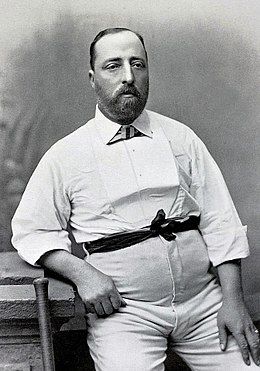On the 29 August 1842, the eminent Victorian cricketer and rugby footballer Alfred Shaw was born in Burton Joyce, Nottinghamshire (1842-1907).
Shaw bowled the first ball in Test cricket, and was the first to take five wickets (5 for 35) in a Test innings. He made two trips to North America and four to Australia, captaining the English team in four Test matches on the all-professional tour of Australia in 1881-1882.

Shaw was one of the few cricketers of his time whose Christian name was used more frequently than his initials. Standing only 5 feet 6½ inches tall, Shaw put on copious weight near the end of his career, and his naturally corpulent build was so dramatically accentuated, he did not look to be the era’s finest medium-pace bowler, but there were few who questioned his credentials
Shaw’s first-class career extended from 1864-1897, and most of his matches were played for for Nottinghamshire. He had the unusual distinction as a professional of frequently captaining the county, which was vindicated when he took Notts. to four successive Championships from 1883 to 1886. He was a natural leader with a powerful personality, but his connection with Notts. all but ended after that last triumph. As his team-mates observed, the county went into rapid decline upon his departure.
During Shaw’s early career, he suggested that the creases should be made by whitewash, and this was gradually adopted through the 1870s. The origin of creases is uncertain but they were in use at the beginning of the 18 century when they were created by scratching, the popping crease being 46 inches in front of the wicket at each end of the pitch. In the course of time, the scratches became cuts which were an inch deep and an inch wide. The cut was in use until the second half of the 19 century when whitewashing replaced it.
In 1881, Shaw led a strike of Notts. professionals, demanding a formal contract of employment to guarantee an automatic benefit at the end of an agreed playing period. The Nottinghamshire Committee thought this was unjustified, and dropped every member of the team who agreed with Shaw. Eventually a reconciliation was reached, and Shaw resumed the captaincy.
Shaw’s first-class bowling average is by far the lowest of any bowler to have taken 2,000 or more wickets, by a substantial margin. But the pitches of the 19 century were far more bowler-friendly than those of today. Still, this did not stop W.G. Grace from asserting that, between 1870 and 1880, Shaw was ‘perhaps the best bowler in England’. Certainly, he was supreme among slow bowlers.
For many years he was on the MCC groundstaff. In 1874 he took all ten wickets for the club in a first-class innings. In 1875, against the MCC, he returned bowling figures of 7 for 7 off 41.2 overs, with 36 maidens.
In 1894, he bowled 422 overs his county, conceding 516 runs and capturing 41 wickets. The following year, at Trent Bridge, a year when it was so cold that K.S. Ranjitsinhji kept his hands in his pockets and fielded the ball with his feet, Shaw bowled 100.1 five-ball overs as his former team accrued 726 runs. He retired 2 matches later, and only returned to the first-class scene in 1897 to play the Gentlemen of Philadelphia.
Shaw helped fellow cricketers Andrew Stoddart and Arthur Shrewsbury to organise what became recognised as the first British Lions rugby union tour of Australia and New Zealand in 1888-1889. The team played 55 matches, winning 27 of 35 rugby union games and 6 out of 18 matches played under Australian rules.
He subsequently became a publican and died in Gedling, Notts. aged 64.
29 August, 2019